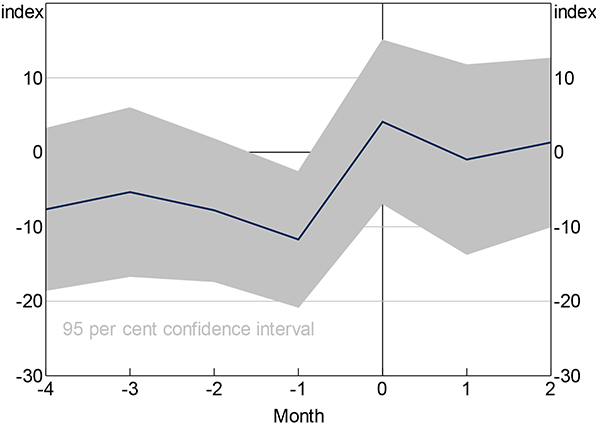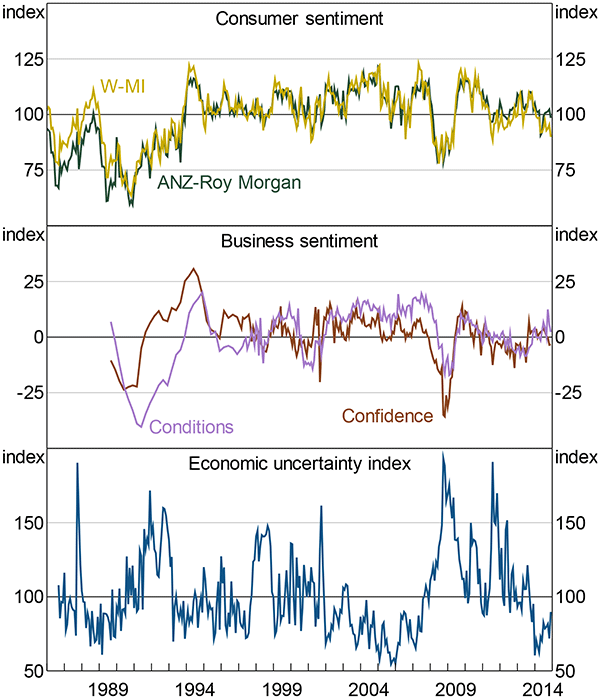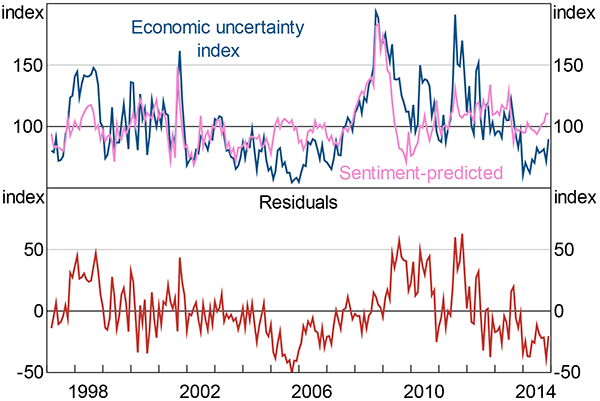RDP 2016-01: Measuring Economic Uncertainty and Its Effects Appendix D: Additional Stylised Facts
February 2016
- Download the Paper 1.07MB
- Data
D.1 Federal Budgets
The story is less clear for federal budgets than for federal elections (Figure D1). The budget month is associated with slightly higher levels of uncertainty, but the months before appear to have lower. Again, because I am not controlling for any other factors, these results simply reflect the average of the index in the relevant month; many other factors are likely at play.[34]

Sources: Author's calculations; Consensus Economics; Factiva; MSCI; Thomson Reuters
D.2 Sentiment and Uncertainty
One argument against the value of the economic uncertainty index is that measures of sentiment already capture the information contained in the index. However, economic uncertainty is conceptually not the same as sentiment. Business and consumer sentiment indices are about the expected level of future outcomes, while uncertainty is about the dispersion or variance of potential outcomes.
But there is a theoretical reason to expect a small link between the two concepts. Theory predicts that consumption and investment should fall when uncertainty is high. Consumers and businesses should lower their expectations in response.
Notwithstanding the conceptual distinction between the two, the measures of sentiment also likely capture some elements of uncertainty and the economic uncertainty index likely captures some elements of sentiment.
There appears to be some evidence of this ‘contamination’ between the two measures: measures of sentiment decrease when uncertainty increases (Figure D2). For business sentiment, the economic uncertainty index has correlation coefficients of −0.53 and −0.63 with the NAB conditions and confidence indices respectively. For consumer sentiment, the correlation coefficients are −0.32 and −0.25 for the Westpac-Melbourne Institute (W-MI) and ANZ-Roy Morgan indices respectively. All are statistically significant at the 1 per cent level.

Note: The business sentiment measures are from the NAB surveys
Sources: ANZ-Roy Morgan; Author's calculations; Consensus Economics; Factiva; MSCI; NAB; Thomson Reuters; Westpac and Melbourne Institute
Given these correlations, sentiment can explain a large proportion – about 40 per cent – of the variation in the economic uncertainty index (Figure D3).[35] While some of the remaining variation is noise, some of it reflects uncertainty-only shocks – that is, changes in the dispersion of possible outcomes without changes to the expected level of outcomes. The clearest example is the July 2011 US debt ceiling stand-off: sentiment was little changed while the economic uncertainty index reached a near-historic peak. Figure D3 also shows that uncertainty lingered after the Lehman Brothers bankruptcy, even though sentiment recovered.

Notes: See note to Figure 5; ‘sentiment-predicted’ is the predicted value of the economic uncertainty index from a regression of the economic uncertainty index on NAB business confidence for the period ahead
Sources: Author's calculations; Consensus Economics; Factiva; MSCI; NAB; Thomson Reuters
Footnotes
As with federal elections (Section 3.5), I tried a specification that attempted to control for foreign-based uncertainty. This did not significantly alter the results. [34]
I use the NAB business confidence series for period-ahead index because it is the best predictor of the variation in the uncertainty index. This might be because both uncertainty and confidence are forward looking. [35]